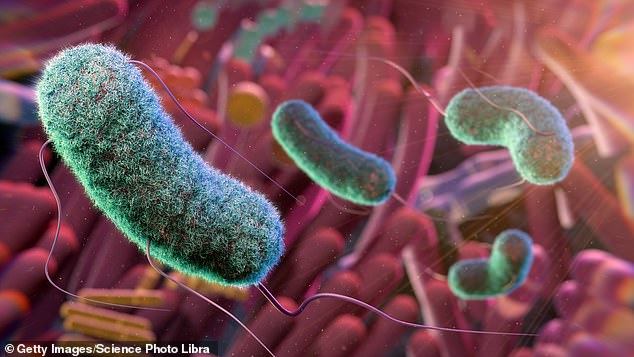Scientists are increasingly discovering new ways that our microbiome – the community of bacteria and viruses that live inside us – is key to our health.
It could even be the source of new antibiotics. Using gut microbiome samples from 1,800 people, researchers in the US have recently identified dozens of microbes that worked against disease-causing bacteria in the lab.
When one of these microbes was then tested on mice infected with a common bacteria, it was as effective as the current last-resort treatment, reported the journal Nature.

Using gut microbiome samples from 1,800 people, researchers in the US have recently identified dozens of microbes that worked against disease-causing bacteria in the lab
But while most of us now know something about the gut microbiome, there are other microbiomes pretty much everywhere – in our lungs, mouths and even in our joints, explains Professor Luigi Nibali, head of the Centre for Host-Microbiome Interactions at King’s College London.
’Although we look human, because there are so many microbes living in our body, 99 per cent of the DNA material inside us is, in fact, the microbes’ DNA.
’A lot of our functions wouldn’t be possible without microbes – we wouldn’t survive without them.’
Here, we reveal what these different microbiomes do, and the steps you can take to nurture the good microbes and weed out the bad…
MOUTH
Some of the microbes living between our teeth are not only responsible for gum disease, but can wreak havoc as they can travel around the body causing inflammation and damage.
Research has linked advanced gum disease to heart attack and stroke, and more recently to dementia, rheumatoid arthritis and even cancer. So good oral hygiene isn’t just about preventing tooth decay.
Plus, some harmful mouth bacteria, including Porphyromonas gingivalis, modify proteins that then trigger the immune system into thinking they are ’foreign’ and mistakenly attack them, for example in the joints – which could explain the connection between gum disease and rheumatoid arthritis.
Separately, simply swallowing bad mouth bacteria can alter the gut’s microbial community – and this has been linked to certain cancers. People with colorectal and pancreatic cancer have been shown to have higher levels of these types of bacteria in their gut tissue, explains Professor Nibali.
Harmful mouth bacteria may also cause pneumonia if they reach the lungs. 'That’s why it’s essential to look after the oral health of people in care homes or hospitals who are unable to clean their teeth,’ he adds.
Mouth bacteria tend to form a biofilm – sticking to each other in hundreds of layers on our teeth. 'This is why antibiotics have a limited effect in the mouth, because it won’t reach all of the layers,’ explains Professor Nibali, who is also a professor of periodontology at King’s College London.
Cleaning under the gum line, by brushing and flossing, disrupts the biofilm and is vital for keeping your oral microbiome healthy, he adds. 'Bad’ bacteria also feed off sugar and refined carbohydrates, such as white bread and cakes.
NOSE
The nasal microbiome contains higher levels of harmful bugs such as Streptococcus and Staphylococcus aureus than other parts of the body because we’re constantly breathing in new microbes.
These bacteria can damage the lungs if they travel there, explains William Cookson, a professor of genomic medicine at Imperial College London: 'There isn’t a huge amount of research, but it’s thought that in a healthy nasal microbiome, the good bacteria – in conjunction with the lining of the nose, mucus and nasal hair – have a role to play in outnumbering the harmful microbes. They probably do this by consuming more nutrients, therefore preventing pathogens from taking hold.’
The good bacteria include strains of Rothia, which have been shown to inhibit the growth of Moraxella catarrhalis in the nose. Moraxella bacteria are associated with ear infections and respiratory illnesses, including asthma.
Lab tests at the University of Wisconsin in 2023 revealed that most strains of Rothia secrete an enzyme that stops Moraxella mutiplying – so potentially could one day be harnessed to treat, and prevent, common respiratory infections.
LUNGS
A diverse lung microbiome helps regulate the immune response. This makes it key to avoiding conditions such as asthma and chronic obstructive pulmonary disease (COPD, the name for a group of incurable conditions, including bronchitis, that damage the air sacs in the lungs), explains Professor Cookson.
’Without diversity, the immune response doesn’t work properly and people are more susceptible to lung disease,’ he says. 'The loss of diversity also allows the overgrowth of harmful bugs, which can damage the airways.’
Modern lifestyles and urban living are to blame for this deficiency, adds Professor Cookson: 'We take a lot of antibiotics, and everything is cleaner than it used to be. Also certain 'protective’ bugs, such as Capnocytophaga, Megasphaera and Selenomonas, which are likely to help control immunity and infection, don’t commonly appear in people living in cities.’
This is, in turn, linked to excessive responses to common viruses such as colds, which could make someone susceptible to asthma.
’We don’t entirely understand why, but if the microbiome is unbalanced, what’s usually a trivial infection triggers an overexuberant inflammatory response, causing asthma attacks or attacks of COPD,’ says Professor Cookson.
In research he co-authored, published in Communications Biology in February, samples from people’s lungs revealed that those who had asthma didn’t have a diverse lung microbiome. Furthermore, this was linked to immune changes in the lining of the lungs.

’Being around cows in particular seems to be beneficial. Cows and other farmyard animals have a rich source of diverse and beneficial microbes which we breathe in if we’re near,’ says Professor Cookson
’The next step is identifying which microbes are essential and finding if there are ways to replace them if they’re missing – by inhaling them in a nebuliser – which could potentially treat conditions such as asthma,’ he says.
Pollution also allows bad bacteria to thrive inside the lungs, meaning viruses cause more damage than they usually would. And smoking hugely impacts the lung microbiome, including causing the overgrowth of harmful Streptococci bugs, Professor Cookson adds. 'It’s likely these bacteria can predispose someone to lung cancer.’
To keep your lung microbiome as diverse as possible, don’t smoke, avoid unecessary antibiotics and, if you live in an urban area, regular exposure to rich microbial environments, such as farms, may help.
Professor Cookson says: 'Being around cows in particular seems to be beneficial. Cows and other farmyard animals have a rich source of diverse and beneficial microbes which we breathe in if we’re near them, and can also pick up on our skin from touching surfaces around them on the farm.’
BREASTS
Emerging evidence suggests there is a microbiome in the breasts. And, in a study published in 2021, researchers from the Cleveland Clinic in Ohio, US, found that breast tissue samples from women with cancer had less microbial diversity than those without cancer – as did those without the disease but who were at high risk (because of genetics or family history).
The bacteria in the breast also differed between types of cancer and with the severity of the disease; Porphyromonas, Lacibacter, Ezakiella and Fusobacterium were often present when the cancer had progressed, for example.
The researchers said in future it may be possible to use probiotics or specific antibiotics to treat or prevent breast cancer.
’There is also a breast milk microbiome, which is primarily dominated by bacteria such as Staphylococcus and Streptococcus, and lower levels of others including Lactobacillus and Bifidobacterium, and which plays a key role in shaping the infant gut microbiome and supporting immune system development,’ says Professor Lindsay Hall, chair of microbiome research at the University of Birmingham.
A study published in Cell just last week shows that breast milk regulates infants’ microbiome during their first year and lowers their risk of developing asthma.
GUT
The microbes in our gut not only affect our digestion, but can have far-reaching effects around the body thanks to by-products such as short-chain fatty acids (produced after bacteria break down fibre).
’High production of short-chain fatty acids is linked with lower levels of inflammation in the gut and around the body; higher levels of inflammation are associated with chronic diseases such as inflammatory bowel disease and Parkinson’s,’ says Dr Alexandre Almeida, a researcher at the University of Cambridge who works on the gut microbiome. (Certain strains are now being investigated as a potential treatment for these conditions, he adds.)
’Short-chain fatty acids make the gut barrier and gut lining really strong and are important for programming our immune system,’ adds Professor Hall. 'They can spread around the body and impact the immune system in other places, too.’
They drive anti-cancer responses, for instance. Indeed 'newer treatments such as checkpoint inhibitors [which ramp up the immune response to fight off cancer cells] may not work as well in people who don’t have the right microbes in their gut to boost the activity of the immune system,’ explains Professor Hall.
’People eating high-fibre diets find these cancer treatments work better than those with low-fibre diets,’ adds Dr Ewan Langan, an honorary lecturer in clinical dermatology at the University of Manchester. Other research published in Nature Medicine in 2022 showed that when combined with immunotherapy, taking an oral dose of live Bifidobacterium significantly extended the survival of patients with kidney cancer, to 12.7 months compared with 2.5 months for those not given the probiotic.
The gut microbiome also affects our brains and is linked to stress and depression, even Parkinson’s, says Dr Almeida.
The microbes can affect the brain in two ways. The first is via our immune system, influencing T helper cells (a type of immune cell) to produce cytokines that send signals to the brain, says Maria Rodriguez Aburto, a senior lecturer in anatomy and neuroscience at University College Cork in Ireland.
The second is that short-chain fatty acids are thought to send signals via the vagus nerve – which connects the gut to the brain – and help modulate brain immune cells called microglia, she explains. These monitor the brain’s environment and can trigger inflammation – for example, to tackle infection.
Chronic inflammation in the brain has been associated with mental health conditions including depression and Parkinson’s.
Research has also pointed to other possible mechanisms: a study in Nature Microbiology in 2019 found that people with better mental health had different gut bacteria that produced precursors to dopamine (a 'feel-good’ chemical). They produce butyrate, a short-chain fatty acid that’s depleted in people with depression.
It also stimulates the activity of the gene responsible for creating the enzyme tyrosine hydroxylase, which is involved in the production of dopamine, says Dr Almeida. Parkinson’s is characterised by depleted levels of dopamine.
Meanwhile, the liver’s ability to regenerate is associated with the gut bacteria Roseburia, which breaks down fibre and produces short-chain fatty acids which, if the levels are high enough, reach the liver and signal to immune cells to become anti-inflammatory. This aids regeneration and reduces inflammation and cirrhosis (scarring).
Gut bacteria could even keep cholesterol levels in check. A lab study published in Cell in April found that strains of Oscillibacter bacteria contained an enzyme which can break down low-density lipoprotein (LDL) cholesterol into a harmless substance, coprostanol, which is excreted rather than absorbed by the body.
To fuel an array of helpful microbes, it’s essential to eat enough fibre (the NHS recommends 30g a day), ideally from different sources (such as wholewheat bread and pasta, potatoes, vegetables, nuts and pulses – and resistant starch, found in potatoes that have been cooked, then cooled down again).
SKIN
The skin microbiome should prevent harmful bacteria colonising it and potentially entering the body through a wound, says Dr Langan, who is the editor-in-chief of the journal Skin Health and Disease. He adds that moisturising daily is important: 'It may be that harmful bacteria are more likely to grow and reproduce when the skin is dry.’
People with skin conditions such as eczema and psoriasis, which are linked to an immune system overreaction, have different skin microbiomes.
’Within areas affected by psoriasis, higher levels of Actinobacteria and Firmicutes are often present, but it isn’t known if the bacteria change due to the patches of [affected] skin, or if the bacteria cause the changes on the skin,’ says Dr Langan.
UV light also affects the skin microbiome – just going outside in the sun can change its composition temporarily and may have a beneficial anti-inflammatory effect.
UV light is used for conditions such as psoriasis, and can have a longer impact in reducing symptoms, possibly because the change in environment on the skin means it’s harder for bacteria to reproduce, says Dr Langan.
Interestingly, a review in the journal Photodermatology, Photoimmunology & Photomedicine last year suggested that because UV filters in sunscreens could make the skin microbiome less diverse, new products should be designed to protect the skin from UV damage but also keep the microbiome healthy.
And be aware that using topical antibiotics – for instance, creams such as fusidic acid, often prescribed for skin infections including impetigo – 'could cause a shift in the microbiome, because while the cream would target specific bacteria, other beneficial strains could also be killed off, so it’s important not to use them unnecessarily’, says Dr Langan, adding that antibacterial soaps and body washes also have the potential to cause an imbalance.
VAGINA
Women have a vaginal microbiome that’s not very diverse – a good thing, unlike with our other microbiomes.
’It should be dominated by Lactobacillus bacteria,’ explains Professor Hall. This bacteria helps to maintain a slightly acidic environment that keeps harmful microbes, such as the candida fungus which causes thrush, under control.
Lower levels of Lactobacillus, and specifically the Lactobacillus crispatus strain, can also lead to an overgrowth of Gardnerella, which is associated with bacterial vaginosis (BV). The latter causes soreness and discharge, and is a risk factor for preterm birth.
Results of a trial by researchers at Imperial College London showed a medication containing Lactobacillus crispatus reduced the risk of preterm birth in women with low levels of the strain. Research published last year in Beneficial Microbes found that a probiotic pill containing Lactobacillus crispatus improved the symptoms in women with thrush and BV after four weeks’ treatment, unlike a placebo group.
Lactobacillus feeds off sugars produced in the vaginal walls in response to oestrogen, so levels may fall around menopause. Treatments that boost oestrogen levels, such as HRT, may help.
Only washing the area with water, while avoiding perfumed products or douching (washing inside the vagina) can all help maintain a healthy microbiome.
While the urinary tract was once considered a sterile environment, it’s now clear it has its own distinct microbiome – and it may play a part in urinary incontinence.
A study published in the American Journal of Obstetrics and Gynaecology in 2020 found that women with the condition had different types of bacteria in their bladder microbiome compared with continent women, with a less diverse mix of species and a higher proportion of Streptococcus anginosus.
JOINTS
In the first study of its kind, a team from the University of Oklahoma discovered microbes living in cartilage from the knees and hips after comparing samples from people with osteoarthritis and healthy controls.
The arthritis group had reduced microbial diversity in their cartilage, with more Betaproteobacteria, while the healthy controls’ samples contained more Alphaproteobacteria and Clostridia. The samples from the hip were also found to be less diverse than the knee samples in both groups.
’The joints are essentially sterile, so we don’t normally expect to find or be able to grow bacteria from there – unless, for example, after surgery or sepsis,’ says Professor Tonia Vincent, an academic rheumatologist at the Kennedy Institute of Rheumatology, University of Oxford. 'Whether microbes have a specific disease-causing role there is not yet known.’
Even sperm has its own microbiome…
While this is a relatively new area of research, specific bacteria colonies of the penis have been linked with conditions such as balanoposthitis (inflammation of the foreskin and head of the penis).
In a study, published in 2021 in the journal Acta Dermato-Venereologica, men with the most severe balanoposthitis had the highest levels of Staphylococcus warneri and Prevotella bivia compared with healthy men. Meanwhile, men with lichen sclerosus, a chronic inflammatory skin condition affecting the foreskin and penis tip, had different penile bacteria compared with healthy men, according to a 2021 study from University College London.
Semen is also thought to have its own microbiome, which could affect a man’s fertility. Men with abnormal sperm motility (how efficiently the sperm move) had a higher prevalence of Lactobacillus iners compared with men with healthy sperm, according to a study published in January in Nature Scientific Reports.
It’s thought this type of bacteria produces an inflammatory form of lactic acid, which has been found to reduce sperm motility – raising the possibility that targeting microbes in the sperm could help with fertility.




